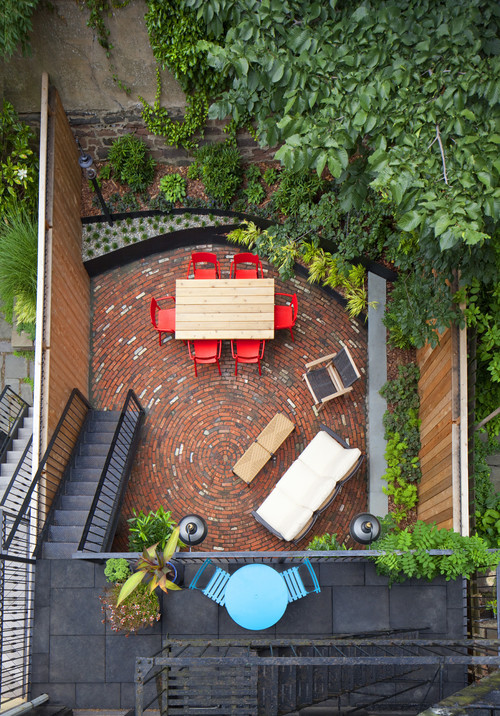
By Lauren Dunec Hoang, Houzz contributor
Gardens are often enjoyed twofold: both in looking out on the garden from the home and by being in the garden itself. Designing gardens specifically to be viewed from above is a concept that originates in Elizabethan times. Think of formal French parterre gardens or classic English knot gardens, both popular in the 16th and 17th centuries. With clipped boxwood hedges, herbs and flowers laid out in designs as intricate as Oriental rugs, these classic gardens were designed to be looked down upon from their owners’ castles and manors.
These days — with much smaller yards and less time to devote to maintaining labor-intensive parterres — there’s still something to be said for considering how a garden looks from above. By balancing shapes, patterns and textures from a bird’s-eye view, you can design a garden that’s not only a pleasure to be in, but also to look down on. Whether your client has a sunken courtyard, a lower-level urban garden or would simply like to look down on an interesting backyard from upstairs windows, here are eight ideas for creating an eye-catching garden when viewed from above.
1. Go for bold geometric forms. When laying out pathways, patios and planting beds, you can create an effective bird’s-eye view with large-scale geometric shapes. Exaggerated forms, such as this dramatic zigzag of a path leading to a fire pit, may be less noticeable while in the garden but puts emphasis on the geometry from above.
2. Use repetition. Repeating forms of plants or pavers can be visually pleasing from above, offering a feeling of balance and calm. Rows of succulents placed equidistant makes a satisfying repetitive pattern along this walkway.
3. Add a water element. Water activates a garden, bringing wildlife, providing sound or, in ponds, reflecting the changing sky patterns. Looking down on water in the garden, much as one would look down on a natural stream in the woods, can be particularly peaceful.
In this terraced garden in Eugene, Oregon, a recycled stock tank brimming with water lilies becomes a bright, reflective focal point of the garden viewed from the deck.
4. Carve out shapes with hardscaping. Look for opportunities to use hardscape materials in patios, decking and in built-in benches that create unexpected geometrical shapes. When viewed from above, this asymmetrical concrete patio made up of different-size concrete pavers is much more visually engaging than a standard rectangular patio. Using two stains for the concrete further emphasizes the shapes in the patio.
5. Get formal. Adopt the classic style for gardens to be viewed from above by planting a proper boxwood parterre. Choose the shapes you would like for the design using graceful spirals or a series of straight-lined, overlapping forms. Fill the spaces between with gravel or leave room for planting herbs and flowers in interior beds.
6. Choose materials with eye-catching patterns. Look for materials that have natural variation in pattern, such as cut stone pavers, or create geometric patterns in how the material is set.
In this backyard in Brooklyn Heights, New York, a brick patio laid out in concentric circles creates an interesting, unexpected pattern to look down on from the house.
7. Select plants to look down on. When choosing plants for gardens designed to be viewed from above, pay particular attention to their form and habit. Evergreens clipped into topiary work well for adding shapes and geometry. Rosette-forming succulents and agaves are visually interesting from above.
For flowering perennials, shrubs and trees, consider those that hold their blossoms upright and above foliage for the best view when looking down. Dogwoods (Cornus spp.), for example, keep their flowers upturned along the tops of branches, giving a fabulous show viewed from above.
8. Consider areas that would otherwise be wasted. Look for places in the landscape that could become gardens designed to be viewed from above, such as the space beneath a floating deck or the lower level of a terrace.
In this Los Angeles garden, a Japanese-inspired composition transforms a sunken space under the stairs. Rock gardens, complete with gravel raked into intricate spirals, work particularly well in areas with little foot traffic.
EDITOR’S NOTE: This article is from Houzz. Hoang is a landscape designer and was previously a garden editor for Sunset Magazine and in-house designer for Sunset’s Editorial Test Garden.


















